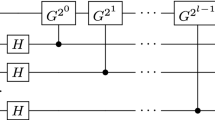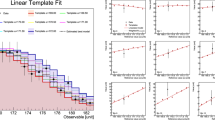Abstract
We consider the ordinary least squares method, which allows solving overdetermined systems of algebraic equations and estimating the error of the obtained solutions. As an important physical example, we determine the four-loop QCD coefficients in the dependence of the relation between poles and running heavy quarks masses on the number of light flavors. For this, we use the existing results of supercomputer calculations of the corresponding four-loop contributions with different fixed numbers of light flavors. We demonstrate the stability of the found solutions under changing the number of considered equations and unknowns.
Similar content being viewed by others
References
A. G. Basuev and A. N. Vasil’ev, “Method of summing the perturbation series in scalar theories,” Theor. Math. Phys., 18, 129–135 (1974).
L. N. Lipatov, “Divergence of the perturbation-theory series and the quasi-classical theory,” Sov. Phys. JETP, 45, 216–223 (1977).
C. Itzykson, G. Parisi, and J.-B. Zuber, “Asymptotic estimates in quantum electrodynamics,” Phys. Rev. D, 16, 996–1013 (1977).
E. B. Bogomolny and V. A. Fateev, “Large order calculations in gauge theories,” Phys. Lett. B, 71, 93–96 (1977).
D. I. Kazakov and D. V. Shirkov, “Asymptotic series of quantum field theory and their summation,” Fortsch. Phys., 28, 465–499 (1980).
V. I. Zakharov, “Renormalons as a bridge between perturbative and nonperturbative physics,” Prog. Theor. Phys. Suppl., 131, 107–127 (1998); arXiv:hep-ph/9802416v1 (1998).
M. Beneke, “Renormalons,” Phys. Rep., 317, 1–142 (1999); arXiv:hep-ph/9807443v2 (1998).
M. Beneke and V. M. Braun, “Renormalons and power corrections,” in: At the Frontier of Particle Physics: Handbook of QCD (M. Shifman and B. Ioffe, eds.), Vol. 3, World Scientific, Singapore (2001), pp. 1719–1773; arXiv:hep-ph/0010208v1 (2000).
A. L. Kataev, “Deep inelastic sum rules at the boundaries between perturbative and nonperturbative QCD,” Modern Phys. Lett. A, 20, 2007–2022 (2005); arXiv:hep-ph/0505230v2 (2005).
I. I. Y. Bigi, M. A. Shifman, N. G. Uraltsev, and A. I. Vainshtein, “Pole mass of the heavy quark: Perturbation theory and beyond,” Phys. Rev. D, 50, 2234–2246 (1994); arXiv:hep-ph/9402360v1 (1994).
M. Beneke and V. M. Braun, “Heavy quark effective theory beyond perturbation theory: Renormalons, the pole mass, and the residual mass term,” Nucl. Phys. B, 426, 301–343 (1994); arXiv:hep-ph/9402364v2 (1994).
R. Tarrach, “The pole mass in perturbative QCD,” Nucl. Phys. B, 183, 384–396 (1981).
N. Gray, D. J. Broadhurst, W. Grafe, and K. Schilcher, “Three-loop relation of quark \(\overline {MS} \) and pole masses,” Z. Phys. C, 48, 673–679 (1990).
L. V. Avdeev and M. Yu. Kalmykov, “Pole masses of quarks in dimensional reduction,” Nucl. Phys. B, 502, 419–435 (1997).
J. Fleischer, F. Jegerlehner, O. V. Tarasov, and O. L. Veretin, “Two loop QCD corrections of themassive fermion propagator,” Nucl. Phys. B, 539, 671–690 (1999); Erratum, Nucl. Phys. B, 571, 511–512 (2000); arXiv:hep-ph/9803493v5 (1998).
K. Melnikov and T. van Ritbergen, “The three-loop relation between the MS and the pole quark masses,” Phys. Lett. B, 482, 99–108 (2000).
K. G. Chetyrkin and M. Steinhauser, “The relation between the MS and the on-shell quark mass at order \(\alpha _{\rm{s}}^{\rm{3}}\),” Nucl. Phys. B, 573, 617–651 (2000).
V. Sadovnichy, A. Tikhonravov, V. Voevodin, and V. Opanasenko, “‘Lomonosov’: Supercomputing at Moscow State University,” in: Contemporary High Performance Computing: From Petascale Toward Exascale (J. S. Vetter, ed.), CRC, Boca Raton, Fla. (2013), pp. 283–307.
P. Marquard, A. V. Smirnov, V. A. Smirnov, and M. Steinhauser, “Quark mass relations to four-loop order in perturbative QCD,” Phys. Rev. Lett., 114, 142002 (2015); arXiv:1502.01030v2 [hep-ph] (2015).
P. Marquard, A. V. Smirnov, V. A. Smirnov, M. Steinhauser, and D. Wellmann, “\(\overline {{\rm{MS}}} \)-on-shell quark mass relation up to four loops in QCD and a general SU(7V) gauge group,” Phys. Rev. D, 94, 074025 (2016); arXiv:1606.06754v2 [hep-ph] (2016).
A. L. Kataev and V. S. Molokoedov, “On the flavour dependence of the \({\cal O}\left({\alpha _{\rm{s}}^{\rm{4}}} \right)\) correction to the relation between running and pole heavy quark masses,” Eur. Phys. J. Plus, 131, 271 (2016); arXiv:1511.06898v4 [hep-ph] (2015).
A. L. Kataev and V. S. Molokoedov, “Multiloop contributions to the \(\overline {{\rm{MS}}} \)-on-shell mass relation for heavy quarks in QCD and charged leptons in QED and the asymptotic structure of the perturbative QCD series,” arXiv:1807.05406v2 [hep-ph] (2018).
Yu. V. Linnik, Method of Least Squares and Principles of the Mathematical Theory of the Development of Observations [in Russian], Fizmatlit, Moscow (1962); English transl. prev. ed.: Method of Least Squares and Principles of the Theory of Observations, Pergamon, New York (1961).
D. J. Gross and F. Wilczek, “Ultraviolet behavior of non-Abelian gauge theories,” Phys. Rev. Lett., 30, 1343–1345 (1973).
H. D. Politzer, “Reliable perturbative results for strong interactions?” Phys. Rev. Lett., 30, 1346–1349 (1973).
P. M. Stevenson, “Optimized perturbation theory,” Phys. Rev. D, 23, 2916–2944 (1981).
R. Lee, P. Marquard, A. V. Smirnov, V. A. Smirnov, and M. Steinhauser, “Four-loop corrections with two closed fermion loops to fermion self energies and the lepton anomalous magnetic moment,” JHEP, 1303, 162 (2013).
P. Ball, M. Beneke, and V. M. Braun, “Resummation of (β 0 α s)n corrections in QCD: Techniques and applications to the tau hadronic width and the heavy quark pole mass,” Nucl. Phys. B, 452, 563–625 (1995); arXiv:hep-ph/9502300v1 (1995).
L. Sachs, Applied Statistics: A Handbook of Techniques, Springer, New York (1984).
Author information
Authors and Affiliations
Corresponding authors
Additional information
Conflict of interest
The authors declare no conflicts of interest.
Prepared from an English manuscript submitted by the authors; for the Russian version, see Teoreticheskaya i Matematicheskaya Fizika, Vol. 200, No. 3, pp. 522–531, September, 2019.
Rights and permissions
About this article
Cite this article
Kataev, A.L., Molokoedov, V.S. Least Squares Method: Application to Analysis of the Flavor Dependence of the QCD Relation Between Pole and Scheme Running Heavy Quark Masses. Theor Math Phys 200, 1374–1382 (2019). https://doi.org/10.1134/S0040577919090101
Received:
Revised:
Accepted:
Published:
Issue Date:
DOI: https://doi.org/10.1134/S0040577919090101




